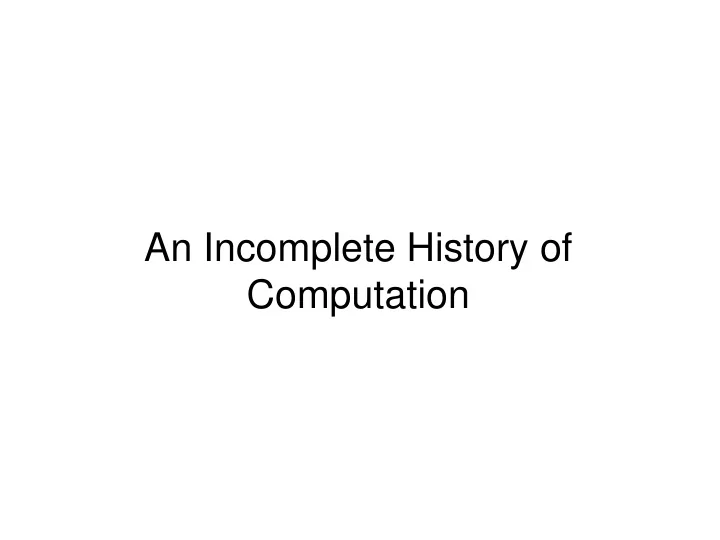

An Incomplete History of Computation
Charles Babbage 1791-1871 Ada Lovelace 1815-1852 Lucasian Professor of Mathematics, Cambridge University, 1827-1839 First computer programmer First computer designer
Difference Engine – Can compute any 6th degree polynomial – Speed: 33 to 44 32-digit numbers per minute! Now the machine is at the Smithsonian Adapted from Arvind and Asanovic ’ s MIT course 6.823, Lecture 1
Analytic Engine The first conception of a general purpose computer 1. The store in which all variables to be operated upon, as well as all those quantities which have arisen from the results of the operations are placed. 2. The mill into which the quantities about to be operated upon are always brought. An operation in the mill required feeding two punched cards and producing a new punched card for the store. An operation to alter the sequence (i.e., a branch) was also provided! Adapted from Arvind and Asanovic ’ s MIT course 6.823, Lecture 1
Analytic Engine 1833: Babbage ’ s paper was published – conceived during a hiatus in the development of the difference engine 1871: Babbage dies – The machine remains unrealized. • Ada Lovelace gets less credit than she deserves -- She essentially invented programming. It is not clear if the analytic engine could be built even today using only mechanical technology Adapted from Arvind and Asanovic ’ s MIT course 6.823, Lecture 1
Harvard Mark I • Built in 1944 in IBM Endicott laboratories – Howard Aiken – Professor of Physics at Harvard – Essentially mechanical but had some electro- magnetically controlled relays and gears – Weighed 5 tons and had 750,000 components – A synchronizing clock that beat every 0.015 seconds Performance: 0.3 seconds for addition 6 seconds for multiplication 1 minute for a sine calculation Broke down once a week! Adapted from Arvind and Asanovic ’ s MIT course 6.823, Lecture 1
7
To this point… • Physical configuration specified the computation a computer performed ENIAC The Difference Engine 8
Electronic Discrete Variable Automatic Computer (EDVAC) • ENIAC ’ s programming system was external – Sequences of instructions were executed independently of the results of the calculation – Human intervention required to take instructions “ out of order ” • Eckert, Mauchly, John von Neumann and others designed EDVAC (1944) to solve this problem – Solution was the stored program computer “ program can be manipulated as data ” • First Draft of a report on EDVAC was published in 1945, but just had von Neumann ’ s signature! – In 1973 the court of Minneapolis attributed the honor of inventing the computer to John Atanasoff Adapted from Arvind and Asanovic ’ s MIT course 6.823, Lecture 1
And then there was IBM 701 IBM 701 -- 30 machines were sold in 1953-54 IBM 650 -- a cheaper, drum based machine, more than 120 were sold in 1954 and there were orders for 750 more! - eventually sold about 2000 of them Users stopped building their own machines. Why was IBM late getting into computer technology? IBM was making too much money! Even without computers, IBM revenues were doubling every 4 to 5 years in 40 ’ s and 50 ’ s. Adapted from Arvind and Asanovic ’ s MIT course 6.823, Lecture 1
Into the 60 ’ s…: Compatibility Problem at IBM By early 60 ’ s, IBM had 4 incompatible lines of computers! 701 7094 650 7074 702 7080 1401 7010 Each system had its own • Instruction set • Peripherals: magnetic tapes, drums and disks • Programming tools: assemblers, compilers, libraries,... • market niche: business, scientific, etc.... IBM 360 Adapted from Arvind and Asanovic ’ s MIT course 6.823, Lecture 3
IBM 360 : Design Premises Amdahl, Blaauw and Brooks, 1964 http://www.research.ibm.com/journal/rd/441/amdahl.pdf • Breaks the link between programmer and hardware • Upward and downward, machine-language compatibility across a family of machines • General purpose machine organization, general I/O interfaces, storage > 32K • Easier to use (answers-per-month vs. bits-per-second) • Machine must be capable of supervising itself without manual intervention OS/360 (simple OS ’ s in IBM 700/7000) • Built-in hardware fault checking and locating aids to reduce down time … the use of the “ ISA ” as a compatibility layer was a $175 billion project (2011 dollars) The Amdahl .. from Amdahl ’ s Law. The Brooks .. from The Mythical Man-Month. Adapted from Arvind and Asanovic ’ s MIT course 6.823, Lecture 3
Recommend
More recommend